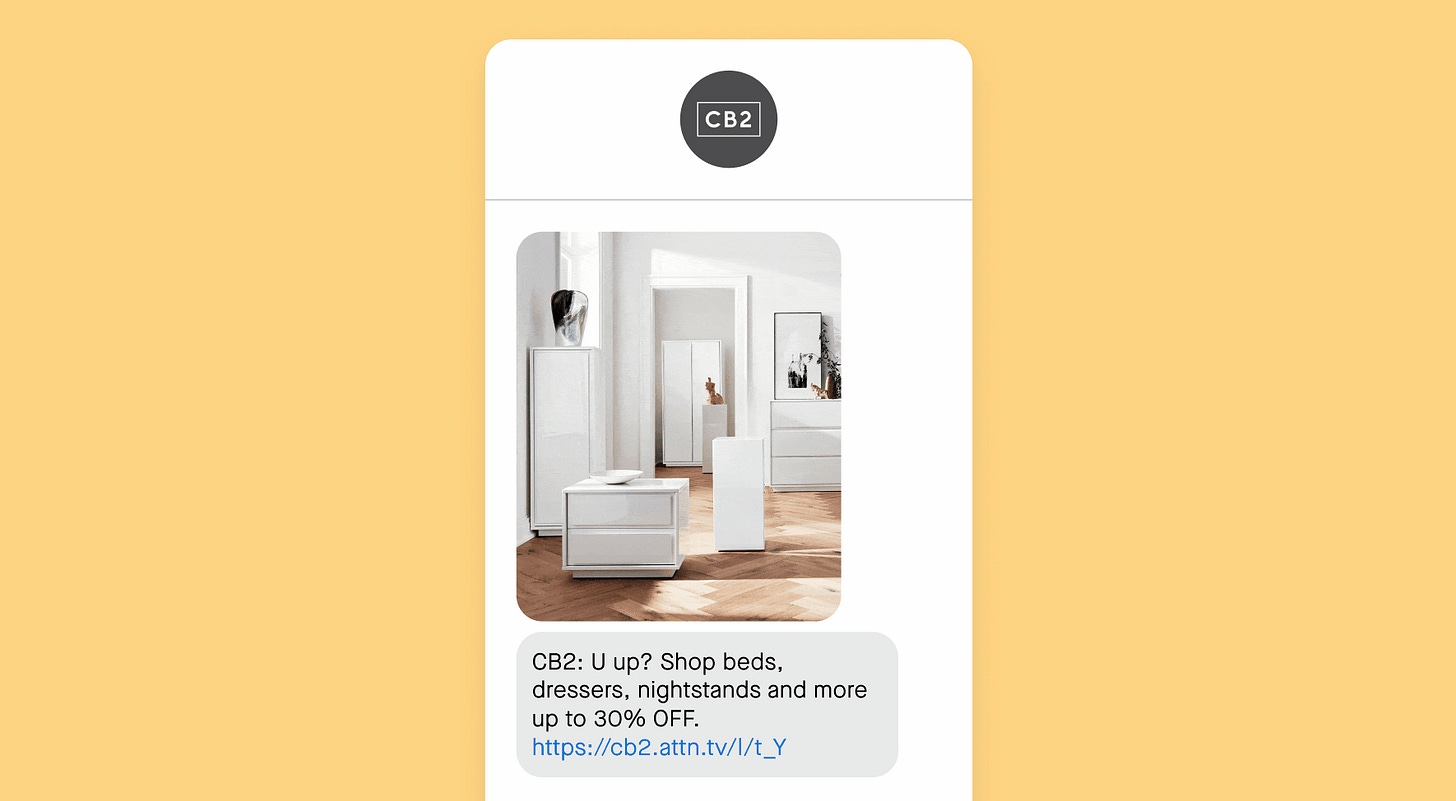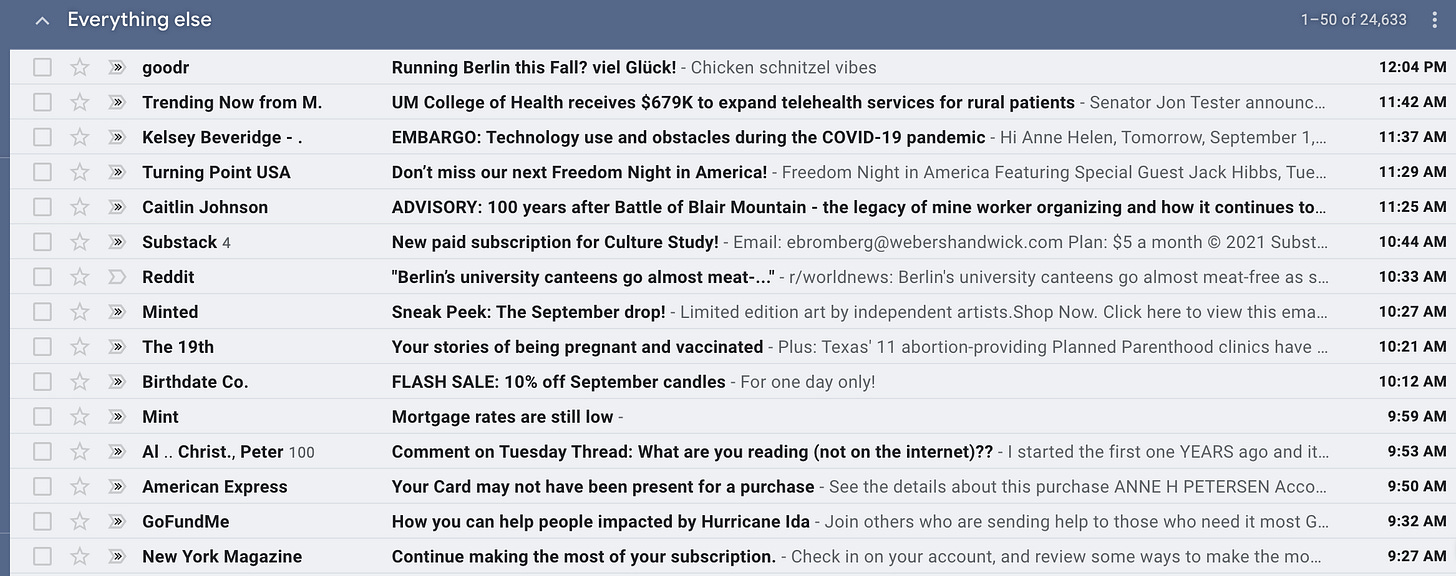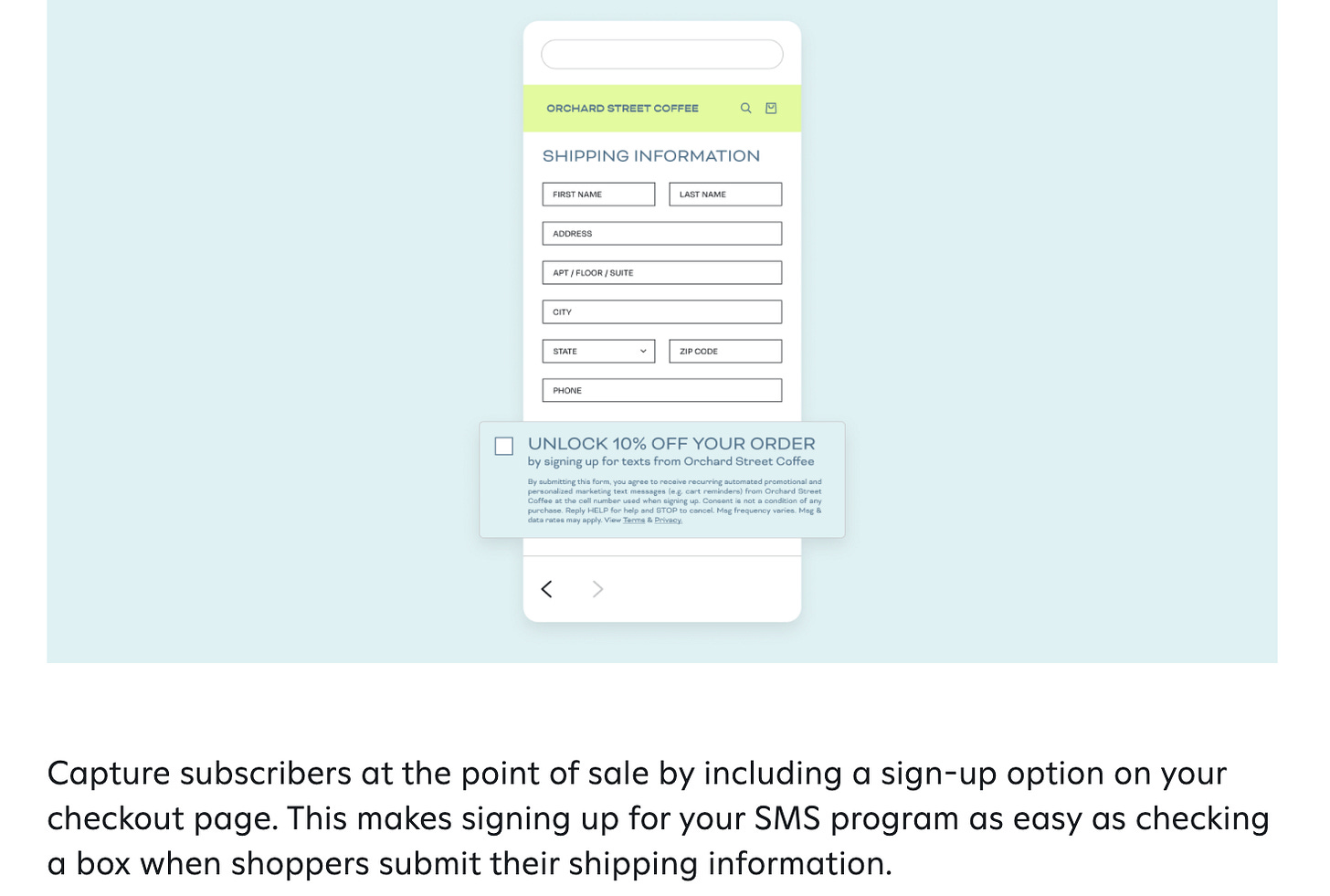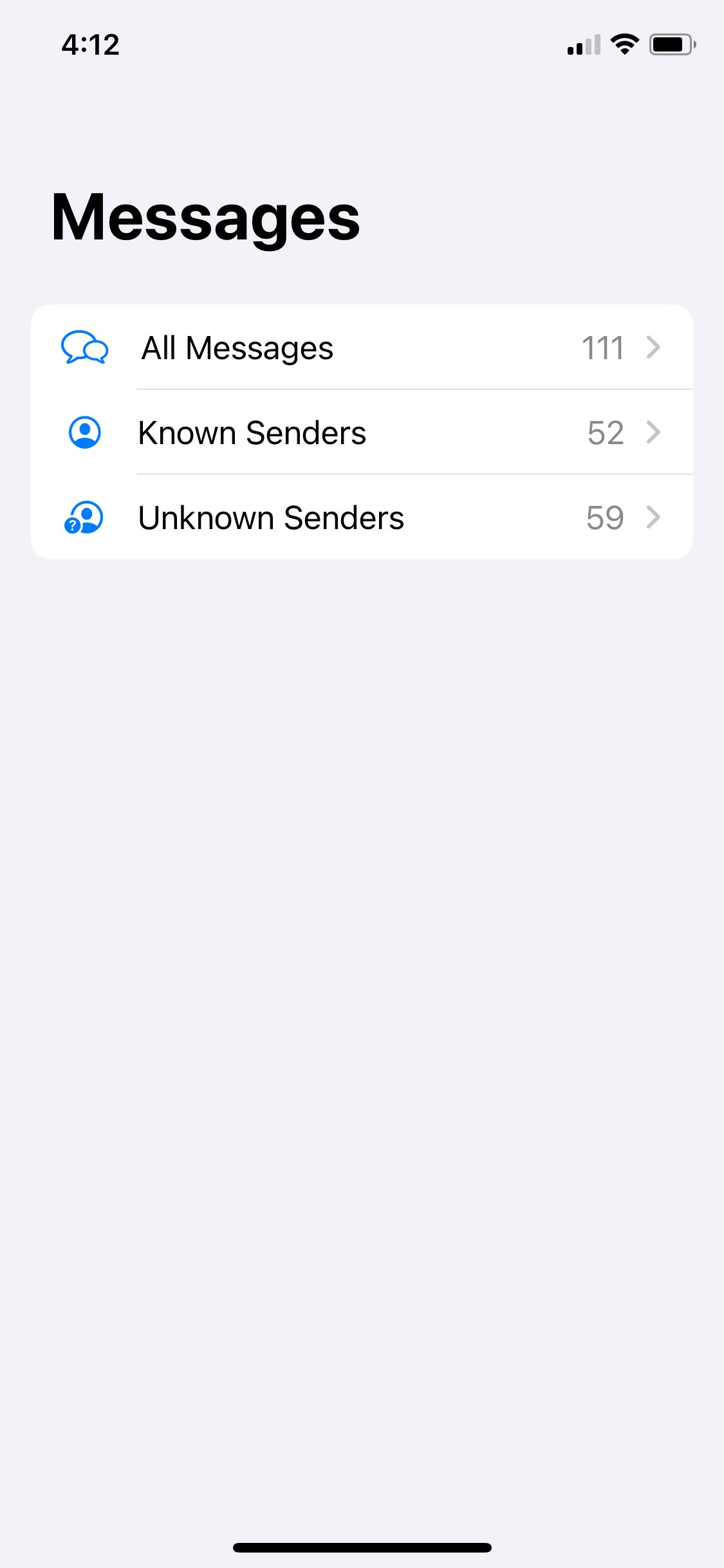The Final Frontier of the Text Inbox
This is the midweek edition of Culture Study — the newsletter from Anne Helen Petersen, which you can read about here. If you like it and want more like it in your inbox, consider subscribing.
Right now, there are 126 unread text messages on my phone. Some people see that number and gasp, but others, they know. Those messages aren’t the result of muted text threads or ignored ex-boyfriends. A few are appointment reminders (from my dentist, from the hairdresser). The rest are all business.
From Food52: 15 brag-worthy make-up ahead lunches!
From Target Circle: You’ve got $14.40 as your balance!
From FarmRio: Meet the NEW Maxi Flowers print and prove that it can be sunny in your wardrobe year-round ☀️ Come say hello now
From ThirdLove: What’s better than an unexpected T Swift album? Getting 25% just for being you. Surprise!
From BevMo: 3-Day Exclusive Online Only Offer! 10% all San Francisco Chronicle Award-Winning Wines. Discount applied at checkout.
Text messages have become the way my credit card asks me about a potentially fraudulent charge. It’s how I interact with Delta customer service. It’s, perhaps naturally, how my wireless provider alerts me of my monthly charges. It’s how my favorite place to get take-out tells me how many loyalty points I’ve accrued, and how my favorite brewery alerts me to what’s new on tap. For certain stores, I get a text when my package is out for delivery.
My text messages inbox is becoming my email inbox — which had previously absorbed the marketing overflow of my mailbox and landline. The reason? Over-saturation. Put differently: my inbox no longer offers the returns brands seek. I use Gmail Priority Inbox, which sorts messages from individuals directly to you (say, an email from my editor) into my ‘actual’ Inbox, and then everything else hangs out in the stew below. Here’s the stew from two and a half hours this morning:
This is after I spent a solid two hours last month deliberately unsubscribing from a number of emails, and after Gmail prompted me every few weeks to unsubscribe from senders whose emails I never open, and after I made liberal use of the “Mark as spam & unsubscribe” button, the efficacy of which, I know, is limited. Point is: I’m trying to bring the stew to a simmer, but the temperature keeps rising. (And yes, there’s a Talking Points USA email in there, when you report on weird things you sometimes subscribe to weird things).
But the stew doesn’t bother me. It doesn’t show up in my email inbox count to stress me out (if you have anyone in your life whose inbox is above five digits, it’s almost certainly because they don’t have this sort of sorting mechanism enabled). But the existence of the stew is a marketing nightmare, because every company feels like the celery that’s basically become invisible and no one wants to eat anyway. They try to figure out ways to become the piece of meat that people actually want, aka, how to get into your priority inbox. (Or, at the very least, how to evade the spam/promotions filtering).
Sometimes that means convincing recipients to open the email enough that the inbox thinks that you like this email sender in the way that you like the actual humans sending you real email. Sometimes it means using subject lines and openers that mimic the language of actual friends, so as to then trick you into opening the email (so that future emails end up in your priority inbox). You click on a sale offer and it all spirals downward from there. West Elm will be emailing you once a day about the last day of its Summer Clearance until you die. Even after you die, maybe even after West Elm dies, the emails will still hit your inbox, like boats against the current, borne back ceaselessly into the past.
Brands and the marketers that work for them are responsible for this trend, but they feed on our inbox behaviors. Those behaviors told these brands that email is the best way to reach us, and then, when asked, most people will say that email is their preferred mode of contact. But those sorts of surveys — and prompts to opt-in to mailing lists — always assume that reachability is a given. Rarely do they ask, 'would you like to receive a barrage of emails from us;’ it’s always ‘how should we alert you to exclusive sale deals?!?’
The inbox has stopped being a place of intimacy or a place of enjoyment. It requires attentiveness in a way that breeds resentment. It’s open all the time on my desktop and I hate it, as most people hate it. The stew has gone bad.
But imagine there’s a new inbox — a place where customers actually spend a lot of time. They love this place, at least most of the time. Their friends are there, in the way they used to be in the email inbox. They pay attention to it, they respond quickly to it. And when you send messages there, the click through rate is bonkers and immediate.
This mythical land is your text inbox, of course. And if it’s not already overflowing with messages from brands, it likely will soon.
For brands, the text inbox functions as a sort of newly-revealed layer of intimacy to colonize. In an interview with Modern Retail, one startup CEO explicitly refers to SMS as “the final frontier of marketing and brand communications.” Marketing firms like RedEye tout average open rates of texts as “99%, with 97% of messages being read within 15 minutes of delivery” and then claim that “it’s clear SMS has the personal touch and that receiving one from a brand feels similar to receiving one from a friend or family member.” In other words, we’re still responding to everything in our text inboxes as if they’re messages from actual people we actually value.
The marketing platform Omnisend, which has 50,000 business clients, reports that their SMS messaging volume went up 378% between 2019 and 2020. In a separate report, 66% of marketing companies that aren’t yet using SMS recently told Attentive, a leading SMS marketing firm, that they plan to start texting customers in the year to come. It’s not because they’re trying to look cool. It’s because these messages are making a lot of money. Attentive’s SMS Benchmarks Report surveyed 400 companies about SMS marketing — and 60% of those companies responded that text campaigns had “significantly or overwhelmingly increased revenue generation.” (Caveat here that Attentive has a vested interest in companies thinking it’s a good idea to use SMS messaging services).
You might not have given it much thought when brands first started showing up in your text inbox, but the brands sure have. At some point in the last year, you’ve probably bought something online and been prompted, either when you first arrived on the page or during checkout, to enter your contact information in order to receive 10% off your purchase. This post from Attentive, for example, provides a step-by-step how-to on how to format the 10% offer and where to have it pop-up:
The first time I succumbed to this pitch, I was looking at some spatulas and wooden spoons from Food52, and the 10% off offer somehow pushed me over the edge. I sold the sanctity of my text inbox for the grand price of $2.90, and now the company texts me about as often as a good friend that lives in another city, and with approximately the same voice, too.
That’s not accidental. When furniture company CB2 decided to start experimenting with SMS marketing, they wanted to approximate the “natural, conversational tone of text messaging,” while matching their “strong brand voice — fun but elevated and edgy.” One of their first messages started with “U up?” followed by….a link to a sale for 30% off. The click-through rate was higher than other messages with a more traditional tone, which, according to Phillip Cruickshank, associate director of brand marketing at the company, “proved to us that we needed to speak to customers differently on this channel.”
As with email, text campaigns can be segmented (by deduced age, income level, sale-hungry behavior) or universal. They can be tailored to end-of-work-day browsing or Sunday afternoon scaries scrolling. Most of mine are cheeky, make liberal use of puns, and have a lot of emojis. I don’t resent them. At least not yet.
And that, too, is purposeful. SMS marketing materials are shot through with warnings to please, for the love that all is holy, do not text too much. The director of Customer Experience and Retention at Olipop told Modern Retail that “SMS is like any fun new marketing thing where right away it can kind of get abused…some brands are now sending three messages a week.” Text too much and you’re going to end up like a person you went on a date with once, and it was fine, but now they won’t stop asking if you want to hang out.
Ultimately, it’s far, far easier — by law — to get rid of a brand’s texts than it is to unsubscribe yourself from an email campaign. You just reply STOP. Or, if that doesn’t work, iMessage will allow you to sort all messages sent from numbers that you don’t know into a secondary folder. It’s the priority inbox all over again, this time for your texts.
The marketing guy at Olipop sees the future of text marketing as rooted in “exclusivity and intentionality,” which also sounds a lot like how “cool” is generated and preserved. But it’s also a pretty apt description of the cultivation of intimacy. You decide who you’re going to let in, and then you nurture that connection through extended contact and reciprocity.
I feel intimate with several causes, and even with some celebrities and micro-influencers I don’t know who’ve fostered a feeling of intimacy through the reproduction of their lives on Instagram. Those people are, ultimately, brands as well — and like brands, they figure out how often to post, as well as the mode of address that’s most in line with other forms of intimate communication in your timeline. Their accounts might have my purchasing information, and be able to target to me in ways I’m not even aware. But they don’t have my phone number — at least not yet.
As a student of cultural studies, I think people have and do find profound meaning in the parasocial relationships they create with people they don’t know —particularly with stars. But intimacy with a brand is hollow intimacy. No matter how effectively they camouflage themselves in your inbox, no matter how much they promise to make your life easier, their primary purpose is ongoing resource extraction. And you are the resource. Brands are not your friends, and they certainly don’t love you back. Their incursion into our last intimate communication space may be a boon for them, but it is a degradation of the actual intimacy that still happens in that space — particularly now, in this extended ever-ongoing pandemic, when other forms of intimacy remain unavailable or scarce.
This might sound like an overreaction — it’s pretty easy to ignore a handful of texts. But I’m sure that others were similarly concerned (and similarly unconcerned) about the arrival of telemarketers to our phones and brands in our inboxes. They’re just telling us about sales! News you can use! Just ignore what annoys you!
But it’s not about the individual emails, or even the individual texts. It’s about what making that space available to brands — and, increasingly, our own employers — does to the space itself. Enjoyment, frivolity, a sense of actual, willful connection: it sours. Texts can be filled with awkwardness and passive aggressiveness, with sorrow and anger. But they’re still communication, real and pulsing, that conceives of us as humans, not as consumers or employees.
In Vermont, there’s a statewide law prohibiting roadside bulletin boards — the culmination of a movement that goes back to the 1930s. When I first moved there, I didn’t even notice. But after a few weeks, I realized how quiet my mind had been on the long drives from the school where I worked into town. My attention was where I wanted it to be: on the road, on the landscape, in the music I was listening to, in my own thoughts.
It shouldn’t be too much to ask for spaces in one’s life that can remain sacrosanct, where we’re not subject to surveillance, where we’re not targeted for sales, where what we make doesn’t have to be immediately commodified and what we do can remain resistant to measure, where we can just shoot the shit and gossip and send pictures of our flowers and kids and dogs and outfits back and forth without being interrupted by a Wayfair sale on patio furniture.
I’m no fool; I know our phones aren’t these ideal spaces. Push alerts and the draw of Twitter and covert tracking codes have already ruined them. What I’m actually describing here — it’s a kitchen table. An intimate, private space where we can be shielded, however temporarily, from everything but each other. But kitchen tables aren’t portable, and in the ongoing absence of others’ kitchen tables from many of our lives, it feels important to preserve the next best thing. It’s imperfect and it’s not much. But it’s an imperfect, not much thing worth protecting.
You might think it’s too late for our text inboxes. But it might not be, not if you realize that the promise of 10% off is very rarely worth whatever information you’re giving over in return. I’m going to go through my inbox right now and text Food52 and Target and Third Love to stop. And then I’m going to text the names above and below those messages, and tell them something weird or random or sappy — you know, the actual building blocks of sustained intimacy. And when they reply, I’ll answer that too.







I'm one of those annoying people for whom email inboxes exist as to-do lists. (I currently have 4—read!—emails in my personal inbox, awaiting my work on them; 3 are in my work inbox.) I reply STOP to all marketing texts as soon as they start. I delete the 6-digit code texts after they have been used. I need my inboxes and my text inboxes clean and uncluttered so that I can attempt to keep my anxiety at a manageable level. So the thing I want most out of iMessage is the ability to MARK A MESSAGE AS UNREAD. Since I can't archive texts the way I can email, I lose too many threads downstream as the day unfolds and messages I read on my way into class that need responses get lost. This function cannot be hard to add, and I cannot figure out why it doesn't yet exist. tl;dr: My kingdom for an "mark as unread" text message option.
This is what Google Voice numbers are for. No one gets my phone number. It’s on Do Not Disturb 100% of the time.
My phone is for my convenience. And no one else’s.